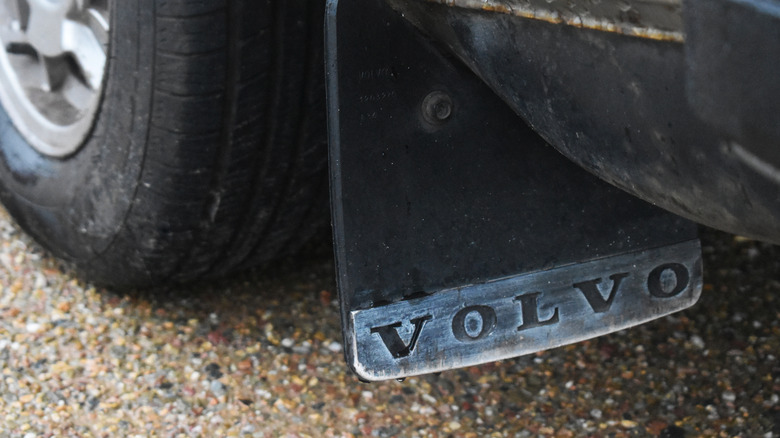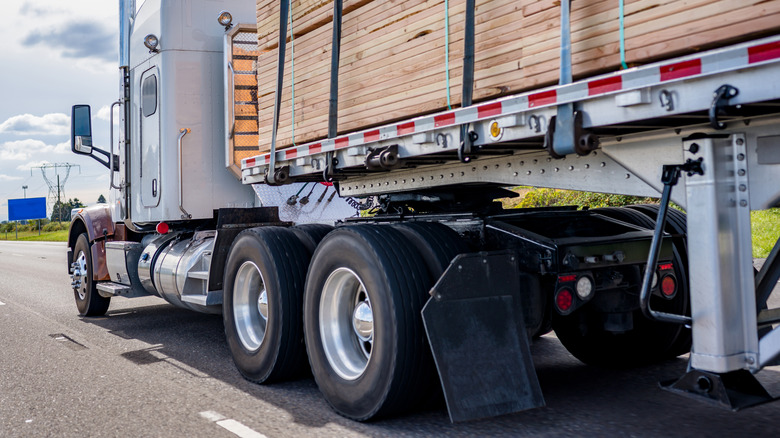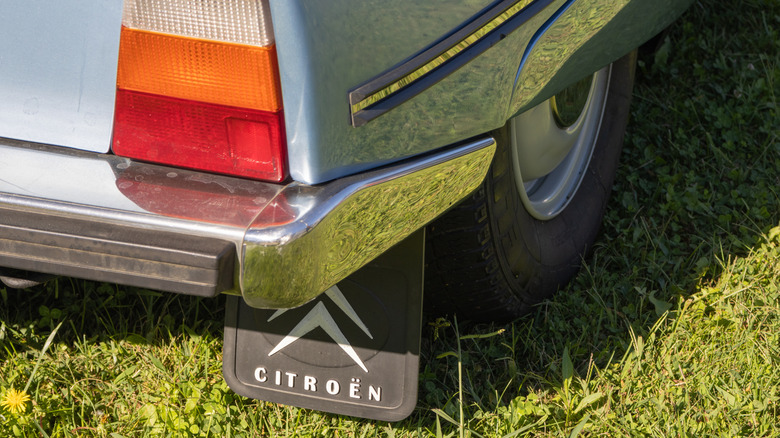Why Aren't Mud Flaps Standard On Cars Anymore?
Since the first cars hit the road over a century ago, they've undergone a drastic transformation. Internally, they're capable of going faster, utilizing heating and cooling technology to keep passengers comfortable, and include state-of-the-art computers to aid in music streaming, navigation, and more. Aesthetically, vehicles come in a host of paint colors — something that can impact your car's resale value — trim styles, and lighting options. Throughout all these changes and innovations, though, some elements have fallen out of favor for one reason or another. For instance, mud flaps aren't as frequent a sight on cars in the modern era as they once were.
While mud flaps aren't entirely absent from roads and parking lots these days, they're definitely not as abundant as they once were. There's not necessarily one single thing that has led to the near-disappearance of mud flaps; however, there are two main reasons many feel are to thank for them becoming less common on passenger vehicles: paved roads and inefficiency.
Once upon a time, mud flaps were used to protect the underside of the vehicle from dirt and debris that the tires could kick up. However, in a time where drives through dirt and mud are less commonplace for standard cars, they've been somewhat phased out. The fact that they don't provide much extra protection for modern vehicles on paved roads doesn't help their case, either.
Of course, this only really pertains to the lack of mud flaps on modern cars. As anyone who has spent any time on the highway could tell you, they're still present on diesel engine-equipped commercial semi-trucks, and for good reason.
While not entirely needed on cars, semi-trucks definitely need mud flaps
It's no secret that commercial trucks — otherwise known as 18-wheelers, semi-trucks, or tractor trailers — aren't your average ride. They're big, not very maneuverable, and are intended for long hauls across continents. Therefore, unsurprisingly, they don't operate in the same ways as an average car. More often than not, these titans of the road are seen equipped with mud flaps. While these serve the same purpose as those previously intended for passenger vehicles, such as preventing debris from damaging the undercarriage over the course of long-distance trips, the size and use cases of large trucks make them a necessity for other reasons.
One of the biggest is the protection of other drivers. Trucks can kick up more dirt, water, mud, and the like due to their larger tires, which can hinder the ability of the person behind them to see and drive safely. Not to mention, small projectiles can damage other vehicles, chipping windshields and paint. Mud flaps also help keep potentially hazardous debris off main roads in case a truck has driven over a muddy jobsite. There's the added benefit of cleanliness, too, since mud flaps are designed to keep dirt and grime at bay and prevent it from caking up on the undercarriage. Surprisingly, mud flaps can even improve fuel efficiency, as they reduce wind resistance and allow the internals of the truck to work less hard.
Clearly, mud flaps bring in a lot of benefits for large trucks, but can passenger vehicles get in on the action? They may not often come with them, but that doesn't mean you can't add them yourself if you feel your driving habits require them.
You can add mud flaps to your car if you'd like
Cars may not typically come with mud flaps straight off the assembly line anymore, but you can add them to your vehicle. Even better, you can more than likely attach them yourself with ease. The specific steps may vary depending on the vehicle, guard style — some require drilling into your vehicle to install them — and brand in question, but in most cases, installation is simple: clean the area they'll cover, remove necessary fasteners around the back end of the wheel well, position the guard, and reattach the fasteners to hold the guard in place.
There are several reasons why someone would want to add mud flaps to their vehicle. As established, if you find yourself driving your vehicle down dirt, muddy, or gravel-covered roads, they do a great job protecting the underside elements. Similarly, they'll contribute somewhat to protecting your car's paint from whatever could be waiting to create chips and dents on debris-covered roads. Some might also want to attach them to their vehicle for aesthetic reasons. Custom-made mud flaps can feature virtually whatever image or text you'd like, adding some individual flare to your ride or, more professionally, serving as advertising for your business.
Though they're seemingly being phased out, mud flaps aren't a bad idea. They may not be essential for the average driver, and they're not the most unique exterior accessories for trucks, but if you're often behind the wheel of a semi-truck or frequently driving on unpaved backroads, you'll likely find their benefits worth it.


